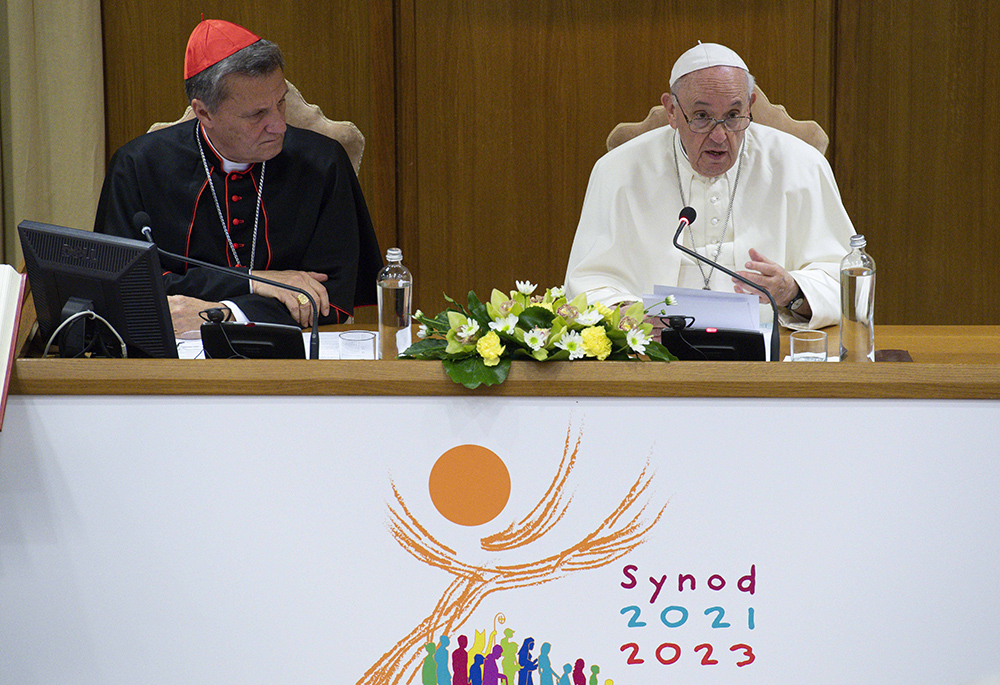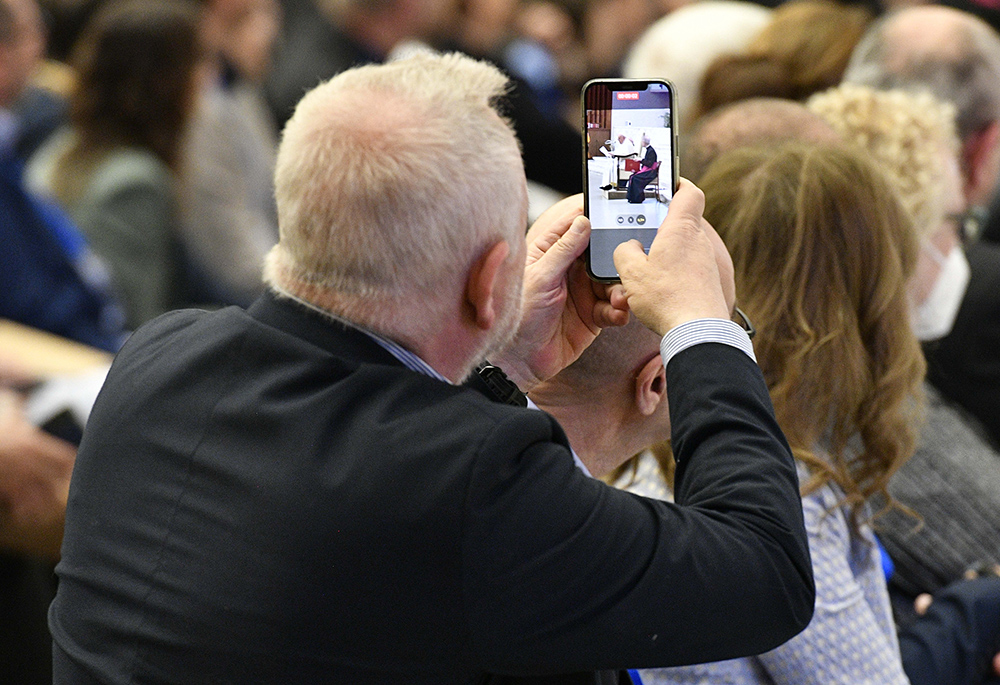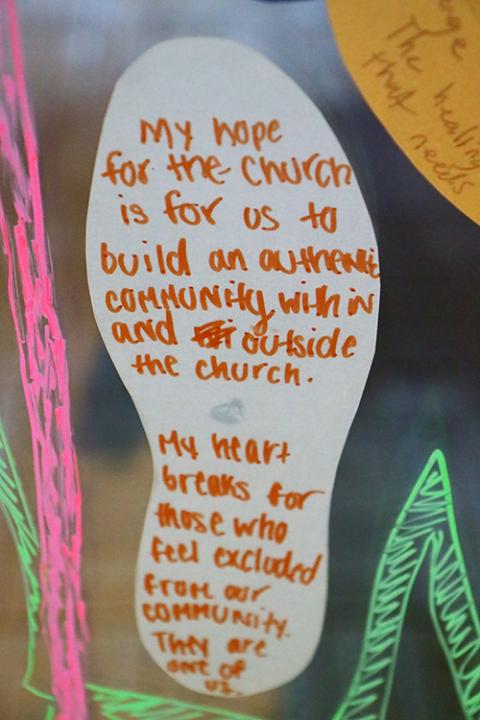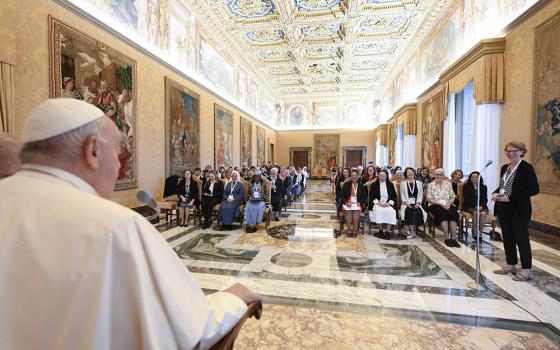
Pope Francis speaks as Maltese Cardinal Mario Grech, secretary-general of the Synod of Bishops, looks on during a meeting with representatives of bishops' conferences from around the world at the Vatican in this Oct. 9, 2021, file photo. (CNS/Paul Haring)
People ask me what I think is going to happen at the first assembly of the two-part Synod of Bishops in Rome this October. I have long had serious reservations about the whole process. My crystal ball is being repaired so I have no earthly idea. Nonetheless, I refuse to join hands with right-wing conservative Catholics, many in the U.S., who condemn the synod as the stuff of the devil. You can almost hear them singing to that old Mary Poppins tune, "Super-synodality-reaps-excommunication" wishing it were Gregorian chant.
I prefer to think constructively about what might turn a laudable idea flawed by structural problems into a truly historic, world-changing event. That might be expecting a lot from religion in a secular age, but human encounter is human encounter and sometimes it has unexpected results.
I offer a few friendly suggestions. If it is too late to implement some this year, there is always next October, and the October after that, and the one after that, which leads to my first suggestion:
1. Make the synod an annual affair.
Let it be like the assemblies of other religious groups — a chance to gather the community in prayer, a place to discuss differences in respectful ways, an opportunity to bask in the infinite variety of the human spirit, a time to set new directions and shape policy.
It does not have to be in Rome every year. In fact, twice might be enough for this century. Think Mongolia, Malta, Argentina, Canada, Nigeria and Australia.
One year it could be regional gatherings; the next year local meetings with international meetings held every once in a while (think carbon footprint, people). But setting aside a few days, or beginning to think about a "Synod Week" worldwide, would be a way to make this much vaunted "walking together" approach more than divisive rhetoric.
A crowd gathers in St. Peter's Square at the Vatican Jan. 15, for the midday recitation of the Angelus led by Pope Francis. (CNS/Vatican Media)
2. Livestream the synod sessions from start to finish.
Pope Francis' declaration to journalists earlier this month that there would be no televising of the synod sessions is disappointing. But it looks as if his Vatican colleagues rescued him from what in the vernacular in Buenos Aires is referred to as a porqueria (politely, "nonsense"), and parts of the assembly will be shared. Concerns for safety for those in danger in their homelands are real and to be handled with care. But the notion of putting large parts of synod activity under "papal secret" seems quaint and extreme in the internet age. Good luck with that.
I urge erring on the side of streaming most of it, but again that might be next year. In 1971, when musician Gil Scott-Heron wrote "The Revolution Will Not Be Televised," his was a call to action, a satirical way to encourage people to abandon their couches and get involved. Fifty years later, watching history unfold is a way to be involved, to include and spark more and different participation. Think Tiananmen Square and Arab Spring, Black Lives Matter protests and women's marches.
Livestreaming all synod plenary sessions is a no-brainer. Small group conversations would be exempt. But opening and closing remarks, prayers, liturgies, guidelines for discussion, and especially the inevitable floor interventions will make for important viewing. At a minimum, they will demystify the whole process, making it more than just a Hail Mary pass to save a sinking institution. Even if the coverage is as boring as watching grass grow, it is everyone's grass and the optics of inclusion are not trivial.

A man takes a video as Pope Francis speaks to members of the Italian bishops' conference and diocesan leaders involved in Italy's national synod process May 25, 2023, in the Vatican audience hall. The pope addressed questions and concerns members of the group submitted about his notion of fostering a "synodal church." (CNS/Vatican Media)
3. Express synodal concepts and ideas in plain language without rhetorical fetishes and flourishes.
The crisis which has forced this synodal process is, in plain English, of the institutional church's own making. It is the fruit of five decades of official refusal to change so that a vibrant religious tradition can endure in postmodernity. Add a global epidemic of clerical sexual abuse and its cover-up by bishops, and the handwriting is on the wall. If this synodal process does not amount to more than another document that few people read, I think the future of Catholicism is in serious peril.
It is anyway, but don't make it worse by using spiritualized language and obfuscating jargon. This boat is taking on water like the Titanic and everyone knows what happened there. The synod, if it lives up to its history and name, is a chance to speak honestly of mistakes and structures that do not work. It is time to beg apologies and listen, listen, listen to the new people in the room, namely, anyone who is not a bishop or above on a ladder that is teetering.
Advertisement
4. Include openly queer people, women priests, and a lot of non-Catholics.
The guest list for the upcoming synod is so heavy on clerics that it is hard to make the case that something different is really envisioned. Of the roughly 364 voting delegates, about 273 are bishops. God forbid they come in their finery. It is not even a bishop with a plus-one. Incremental change on this one won't cut it. We live in a visual age so convincing people that something new (albeit old) is happening here will be impossible. A synod worth its salt needs to look more like a parish association gathering, not the corporation's board meeting.
That no openly queer people are on the current roster is lamentable. The operative word is "openly," and how sad is that? Given the high percentage of gay men in the Catholic clergy, I would guess that those at the synod could fill more than a few of the roundtables at which participants will sit and discern.

A student's message about participating in listening sessions in preparation for the 2023 world Synod of Bishops on synodality is seen April 4, 2022, at La Salle University in Philadelphia. (CNS/CatholicPhilly.com/Sarah Webb)
The shame is that highly skilled and committed LGBTQI+ people from groups like DignityUSA and the Global Network of Rainbow Catholics are not front and center. If there is to be the merest mention of same-sex anything it must include out people speaking their truths: "Nothing about us without us," or the whole thing is a sham. How tragic that some LGBTQI+ people will participate, but not be able to bring their full selves to the table.
Similarly, the hoped-for discussion about women deacons and the indefensible ban on talking about women priests pale before the reality of Catholic women who are already engaged in the same work as ordained men. Roman Catholic women priests, both from the eponymous organizations and those now ordained in Anglican, Lutheran, or other communions, would bring a touch of reality to a still largely abstract conversation.
Women are ministering, including sacramentally, and the sun is coming up the next day. What needs to be addressed is how Catholics think about the ordination of anyone. Why not invite some of these women to talk as equals? Some women's groups (Roman Catholic Women Priests and Association of Roman Catholic Women Priests, for example) have bishops they could send, if anyone were still interested in standing on that ceremony. But a robust conversation with women who wish to serve and have been excommunicated for their willingness to do so would give the often vacuous term "discernment" a good name.
5. Finally, the elephant in the synod aula is the matter of papal power, the fact that the pope speaks first, last, and always despite synodal claims to build consensus before doing anything.
It is a sweet theory, but in practice, as was clear after the synod for the nine-nation Amazon region, lack of consensus can cover a multitude of sins. And, according to present polity, what changes accrue are those that the pope makes. Nothing new here.
So, one has to ask if this synod is really more than a charade, a way to keep people busy, thinking they are doing something useful when that is not altogether clear. Moreover, being able to vote, and even voting in the majority does not assure anything. Papal protestations that a synod is not a parliamentary project ring hollow. I fear that a synod without a change in ecclesial structures will only further cement an already problematic model of church.
The real story in Rome in October will probably be outside the hall, where progressive groups will express their faithful views in creative ways. No invitations needed. Stay tuned to the livestream and let's see what shakes in Rome in the beautiful weather and in the full glare of bright lights. We can but hope.






